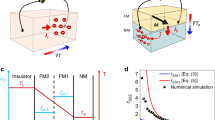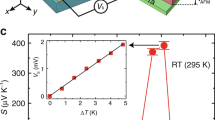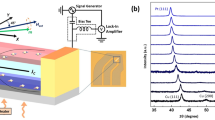Abstract
Thermoelectric generation is an essential function in future energy-saving technologies1,2. However, it has so far been an exclusive feature of electric conductors, a situation which limits its application; conduction electrons are often problematic in the thermal design of devices. Here we report electric voltage generation from heat flowing in an insulator. We reveal that, despite the absence of conduction electrons, the magnetic insulator LaY2Fe5O12 can convert a heat flow into a spin voltage. Attached Pt films can then transform this spin voltage into an electric voltage as a result of the inverse spin Hall effect3,4,5,6,7,8,9,10,11,12. The experimental results require us to introduce a thermally activated interface spin exchange between LaY2Fe5O12 and Pt. Our findings extend the range of potential materials for thermoelectric applications and provide a crucial piece of information for understanding the physics of the spin Seebeck effect13.
This is a preview of subscription content, access via your institution
Access options
Subscribe to this journal
Receive 12 print issues and online access
$259.00 per year
only $21.58 per issue
Buy this article
- Purchase on Springer Link
- Instant access to full article PDF
Prices may be subject to local taxes which are calculated during checkout



Similar content being viewed by others
References
Ashcroft, N. W. & Mermin, N. D. Solid State Physics 253–258 (Saunders College, 1976).
DiSalvo, F. J. Thermoelectric cooling and power generation. Science 285, 703–706 (1999).
Dyakonov, M. I. & Perel, V. I. Current-induced spin orientation of electrons in semiconductors. Phys. Lett. A 35, 459–460 (1971).
Hirsch, J. E. Spin Hall effect. Phys. Rev. Lett. 83, 1834–1837 (1999).
Murakami, S., Nagaosa, N. & Zhang, S-C. Dissipationless quantum spin current at room temperature. Science 301, 1348–1351 (2003).
Sinova, J. et al. Universal intrinsic spin Hall effect. Phys. Rev. Lett. 92, 126603 (2004).
Kato, Y. K., Myers, R. C., Gossard, A. C. & Awschalom, D. D. Observation of the spin Hall effect in semiconductors. Science 306, 1910–1913 (2004).
Wunderlich, J., Kaestner, B., Sinova, J. & Jungwirth, T. Experimental observation of the spin-Hall effect in a two-dimensional spin–orbit coupled semiconductor system. Phys. Rev. Lett. 94, 047204 (2005).
Saitoh, E., Ueda, M., Miyajima, H. & Tatara, G. Conversion of spin current into charge current at room temperature: Inverse spin-Hall effect. Appl. Phys. Lett. 88, 182509 (2006).
Valenzuela, S. O. & Tinkham, M. Direct electronic measurement of the spin Hall effect. Nature 442, 176–179 (2006).
Kimura, T., Otani, Y., Sato, T., Takahashi, S. & Maekawa, S. Room-temperature reversible spin Hall effect. Phys. Rev. Lett. 98, 156601 (2007).
Mosendz, O. et al. Quantifying spin Hall angles from spin pumping: Experiments and theory. Phys. Rev. Lett. 104, 046601 (2010).
Uchida, K. et al. Observation of the spin Seebeck effect. Nature 455, 778–781 (2008).
Wolf, S. A. et al. Spintronics: A spin-based electronics vision for the future. Science 294, 1488–1495 (2001).
Žutić, I., Fabian, J. & Das Sarma, S. Spintronics: Fundamentals and applications. Rev. Mod. Phys 76, 323–410 (2004).
Maekawa, S. (ed.) Concept in Spin Electronics (Oxford Univ. Press, 2006).
Johnson, M. & Silsbee, R. H. Thermodynamic analysis of interfacial transport and of the thermomagnetoelectric system. Phys. Rev. B 35, 4959–4972 (1987).
Hatami, M., Bauer, G. E. W., Zhang, Q-F. & Kelly, P. J. Thermal spin-transfer torque in magnetoelectronic devices. Phys. Rev. Lett. 99, 066603 (2007).
Bauer, G. E. W., MacDonald, A. H. & Maekawa, S. (eds) Spin Caloritronics, Special Issue of Solid State Communications (Elsevier, 2010).
Slonczewski, J. C. Current-driven excitation of magnetic multilayers. J. Magn. Magn. Mater. 159, L1–L7 (1996).
Kajiwara, Y. et al. Transmission of electrical signals by spin-wave interconversion in a magnetic insulator. Nature 464, 262–266 (2010).
Callen, H. B. The application of Onsager’s reciprocal relations to thermoelectric, thermomagnetic, and galvanomagnetic effects. Phys. Rev. 73, 1349–1358 (1948).
Hansen, P., Witter, K. & Tolksdorf, W. Magnetic and magneto-optic properties of lead- and bismuth-substituted yttrium iron garnet films. Phys. Rev. B 27, 6608–6625 (1983).
Tserkovnyak, Y., Brataas, A. & Bauer, G. E. W. Enhanced Gilbert damping in thin ferromagnetic films. Phys. Rev. Lett. 88, 117601 (2002).
Foros, J., Brataas, A., Tserkovnyak, Y. & Bauer, G. E. W. Magnetization noise in magnetoelectronic nanostructures. Phys. Rev. Lett. 95, 016601 (2005).
Xiao, J., Bauer, G. E. W., Maekawa, S. & Brataas, A. Charge pumping and the colored thermal voltage noise in spin valves. Phys. Rev. B 79, 174415 (2009).
Xiao, J., Bauer, G. E. W., Uchida, K., Saitoh, E. & Maekawa, S. Theory of magnon-driven spin Seebeck effect. Phys. Rev. B 81, 214418 (2010).
Demokritov, S. O., Hillebrands, B. & Slavin, A. N. Brillouin light scattering studies of confined spin waves: Linear and nonlinear confinement. Phys. Rep. 348, 441–489 (2001).
Sanders, D. J. & Walton, D. Effect of magnon–phonon thermal relaxation on heat transport by magnons. Phys. Rev. B 15, 1489–1494 (1977).
Schneider, T. et al. Realization of spin-wave logic gates. Appl. Phys. Lett. 92, 022505 (2008).
Acknowledgements
The authors thank B. J. van Wees, K. Sato, Y. Suzuki, G. Tatara, W. Koshibae, K. M. Itoh, and M. Matoba for valuable discussions. This work was supported by a Grant-in-Aid for Scientific Research in Priority Area ’Creation and control of spin current’ (19048009, 19048028), a Grant-in-Aid for Scientific Research A (21244058), the Global COE for the ’Materials Integration International Centre of Education and Research’ all from MEXT, Japan, a Grant for Industrial Technology Research from NEDO, Japan, Fundamental Research Grants from CREST-JST, PRESTO-JST, TRF, and TUIAREO, Japan, the Dutch FOM foundation, EC Contract IST-033749 ‘DynaMax’, and National Natural Science Foundation of China (10944004).
Author information
Authors and Affiliations
Contributions
K.U. designed the experiment, collected all of the data, and performed analysis of the data. E.S. planned and supervised the study. K.U., H.U. and H.K. fabricated the samples. T.O. and Y.K. supported the experiments. J.X., H.A., J.O., S.T., J.I., G.E.W.B. and S.M. developed the explanation of the experiment. K.U., J.X., H.A., G.E.W.B. and E.S. wrote the manuscript. All authors discussed the results and commented on the manuscript.
Corresponding author
Ethics declarations
Competing interests
The authors declare no competing financial interests.
Supplementary information
Supplementary Information
Supplementary Information (PDF 502 kb)
Rights and permissions
About this article
Cite this article
Uchida, K., Xiao, J., Adachi, H. et al. Spin Seebeck insulator. Nature Mater 9, 894–897 (2010). https://doi.org/10.1038/nmat2856
Received:
Accepted:
Published:
Issue Date:
DOI: https://doi.org/10.1038/nmat2856
This article is cited by
-
Enhanced spin Seebeck effect via oxygen manipulation
Nature Communications (2023)
-
Interplay between diffusion and magnon-drag thermopower in pure iron and dilute iron alloy nanowire networks
Scientific Reports (2023)
-
Chiral-phonon-activated spin Seebeck effect
Nature Materials (2023)
-
News and views (1&2)
AAPPS Bulletin (2023)
-
Universal behaviors of magnon-mediated spin transport in disordered nonmagnetic metal-ferromagnetic insulator heterostructures
Frontiers of Physics (2023)



